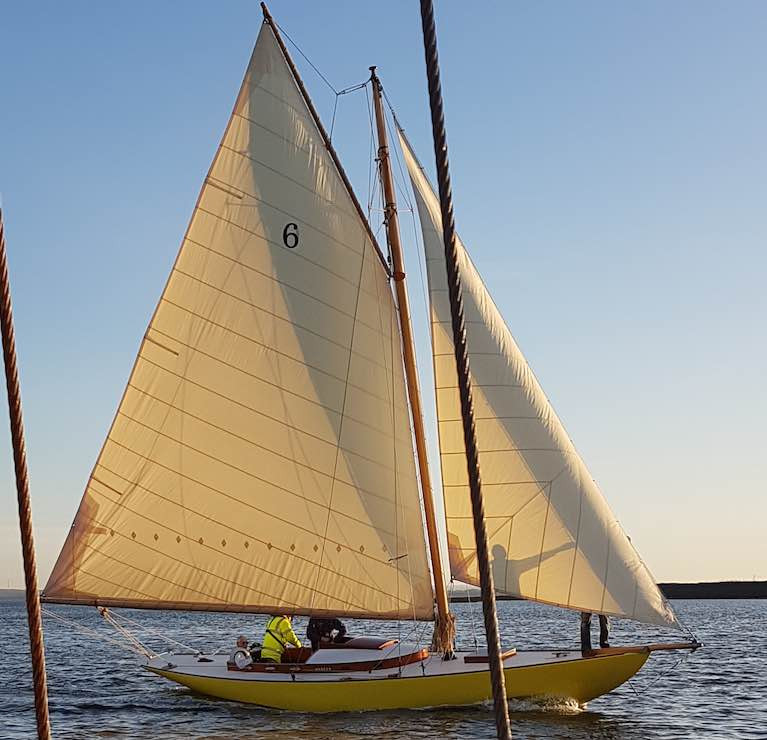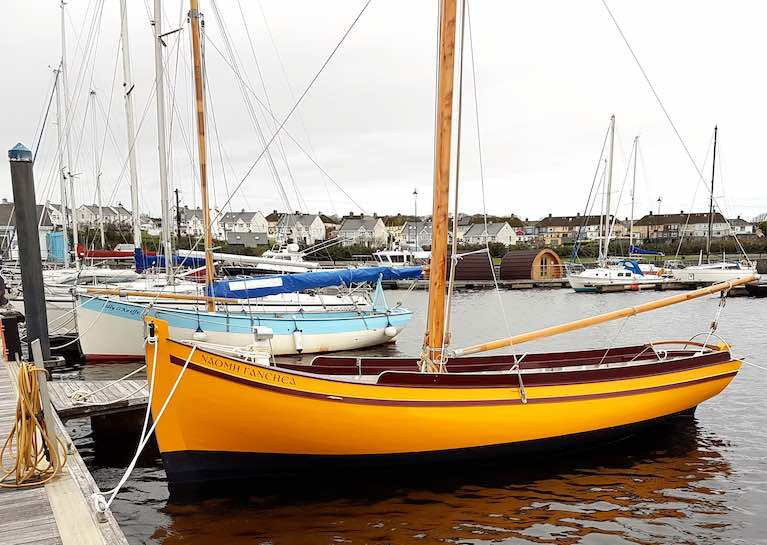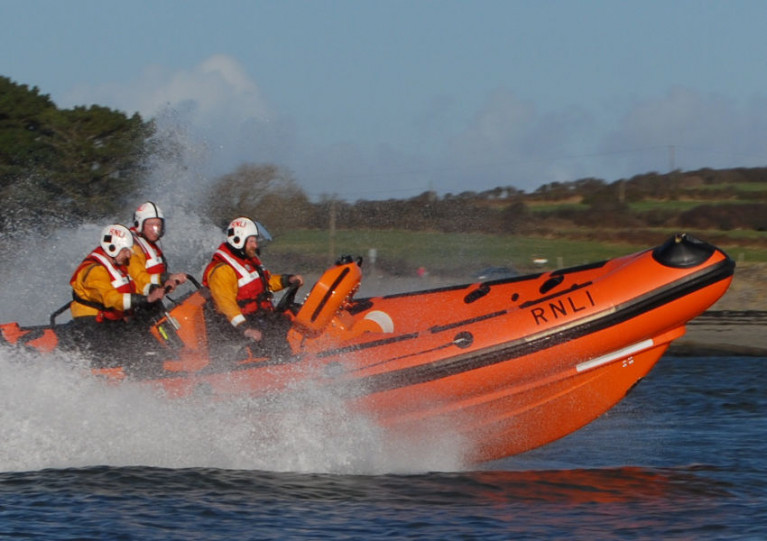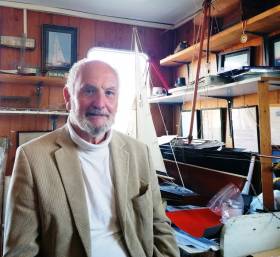Displaying items by tag: Kilrush
Kilrush Lifeboat Assists Two on Adrift Fishing Vessel
Kilrush RNLI’s volunteer crew launched their inshore lifeboat on Friday morning (10 November) to assist two people onboard a fishing vessel that was adrift in challenging conditions.
At 9am, the lifeboat launched at the request of Valentia Coast Guard to a report that a fishing vessel had lost power and was drifting close to the busy shipping channel of the Shannon Estuary.
The crew located the nine-metre fishing vessel with two people onboard south-west of Kilredaun Head.
Having assessed the situation, it was decided to establish a tow line which was done in a challenging sea state and the casualty vessel was towed to Carrigaholt Pier in four- to five-metre swells.
Once the casualty vessel was safely secured, Kilrush RNLI returned to station at 10.30am.
Commenting on the call-out, Charlie Glynn, Kilrush lifeboat press officer said: “Weather conditions were challenging but our volunteer crews are well prepared and trained for each eventuality.
“We are fortunate to have such a dedicated team of volunteers at Kilrush Lifeboat Station who are ready to drop everything at a moment’s notice to save lives at sea. Pease remember if you see someone in danger in the water, call 999 or 112 and ask for the coastguard.”
Five Kilrush RNLI volunteers have received meritorious awards from the RNLI for their part in a 2020 rescue that saved the lives of three people in storm-force conditions.
Shannon Foynes Port Company were also recognised by the charity for their support to the station during the call-out.
On Monday (10 July), Anna Classon, RNLI Head of Region presented helm Tom Blunnie with a RNLI Chairman’s Letter of Thanks and volunteer lifeboat crew members Ian Lynch, Charlie Glynn and Ger Keane with a Chief Executive’s Commendation.
Fintan Keating, the Kilrush lifeboat launching authority, received a Lifesaving Operations Director’s Letter of Commendation for his role in the service.
And a Operations Director’s Commendation was awarded to Shannon Foynes Port Company for their collaborative and valued support in the rescue.
On 28 June 2020 at 11.25pm, Kilrush Lifeboat station was notified by Valentia Coast Guard that a 7m vessel with three people onboard was in grave danger, seven nautical miles south-west of Kilrush lifeboat station in Co Clare.
Weather conditions were near storm force from the northwest, with squally rain, poor visibility and heavy swell in the Shannon estuary. High water was due just after midnight and the flood tide would contribute to a worsened sea state.
Fintan Keating, alongside deputy launching authorities Shawna Johnson and Paul Coady, considered and accepted the launch request.
Upon launch, further communications confirmed the casualty crew were attempting to move their vessel to the harbour at Carrigaholt. However, they had suffered engine failure and were taking on water, drifting towards shipping lanes.
Kilrush lifeboat helm Tom Blunnie, supported by crew members Ian Lynch, Charlie Glynn and Ger Keane, commenced a search for the casualty.
In challenging sea conditions, the casualty vessel was located with assistance from Shannon Foynes Port Company’s Pilot Station.
On arrival, it was found that the casualty crew were unsuccessfully attempting to bail out water, and they were quickly transferred from their now submerged boat onto the lifeboat
Working swiftly as one crew, a towline was established and a course set for Carrigaholt pier. The vessel was safely towed to the pier and the casualties handed into the care of family members.
The charity found that the prompt actions ensured three lives were saved.
Shawna Johnson, acknowledged the tremendous efforts of the team at Kilrush Lifeboat station: “I am incredibility proud reading the Letters of Commendation received by the volunteers involved in the rescue. Exceptional leadership, determination and commitment, were used to describe the efforts of our crew.
“It was a challenging service and undoubtedly the actions of Kilrush RNLI saved three lives.”
In presenting the awards, Anna Classon added: “It fills me with pride to come to Kilrush and present these awards. The actions of the crew that night, carried out in weather conditions, that were on the operational limits of the station’s Atlantic 85 lifeboat, were incredibly brave.
“Our volunteers live and work in the communities where these rescues happen, putting aside time with families and in jobs, to go out in all weathers. Every lifeboat launch is about trust; in each other, in the equipment used to save lives, in the training given and in our search and rescue partners.”
Kilrush Adds St Ayles Skiff to Shannon Estuary’s Growing Traditional Fleet
Kilrush may be best known internationally these days as the place where the Dublin Bay 21 fleet - originally from 1902 - is being re-born through the developing skills of the Steve Morris-led boat-building team in the south Clare harbour town.
But the local maritime group Seol Sionna have long been noted for their breadth of interests, and though their flagship continues to be the charismatic 25ft Shannon Hooker re-creation Sally O’Keeffe – one of the best-looking character boats in Ireland – the group’s members and associates take in a wide selection of craft, one of the more recent being a new-build gleoiteog – the Naomh Fanchea – which chimes very well with the spirit of the times as her auxiliary is an electric motor.
 The St Ayles skiff concept is now well proven
The St Ayles skiff concept is now well proven
In recent months as pandemic regulations ease, Seol Sionna have added yet another dimension by building themselves a St Ayles skiff in one of Steve Morris’s sheds under the tutelage of Steve himself. Although the 22ft St Ayles design by Iain Oughtred has very specific origins at Fair Isle in the far north beyond Scotland, midway between the Orkneys and Shetland, the result – thanks to edge-glued marine ply clinker construction with just six planks per side – is a four-oared easily-handled craft of notable lightness, a more manageable proposition for a small group than the traditional 32ft Irish coastal rowing skiff.
 The new Kilrush skiff starts to take shape
The new Kilrush skiff starts to take shape
 The new skiff ready for turning in Kilrush – any Viking would feel at home with this hull shape
The new skiff ready for turning in Kilrush – any Viking would feel at home with this hull shape
For an organisation like Seaol Sionna, this offers the option of easy trailering to rowing and trad-sailing events at some distance from Kilrush. For although Kilrush undoubtedly feels like the hub of the universe when you’re actually there, other “less important” traditional boat centres tend to seem a long way away, and maintaining healthy interaction with them will be facilitated by a proper road trailer being part of the grant package which made the project possible.
 The traditional classic Sally O’Keeffe slipping effortlessly along on a sunny Shannon Estuary evening
The traditional classic Sally O’Keeffe slipping effortlessly along on a sunny Shannon Estuary evening
That said, most of the new boat’s activity will be in the Shannon Estuary, and as she is just about as different as possible in concept from the hefty but surprisingly swift Sally O’Keeffe, a certain level of competition can be expected in the local sailing waters round Scattery Island. The St Ayles boat may be primarily a rowing craft, but they can give a good account of themselves under sail, and the challenge is right there, ready and waiting.
 Encouraging junior sailing talent at the helm – Sally O’Keeffe plays a central role in the maritime life of Kilrush.
Encouraging junior sailing talent at the helm – Sally O’Keeffe plays a central role in the maritime life of Kilrush.
Kilrush RNLI’s Lifeboat Operations Manager Preparing for Her First Christmas On Call
Nine months into her role as lifeboat operations manager at Kilrush RNLI, Shawna Johnson is preparing for her first Christmas on call since taking up the management of the Co Clare lifeboat station.
As the charity launches its Christmas appeal, Shawna — who has been volunteering with Kilrush RNLI since 2013 — is preparing her crew to swap their turkey and pudding for the cold waters of the sea should the call for help come in.
She is urging the public to help her crew and the thousands of other volunteer crews carrying pagers over the Christmas period to continue their lifesaving work.
As LOM, Shawna is responsible for all operational activities at the lifeboat station including authorising the launch of the inshore lifeboat and the day-to-day management of the station.
“I was appointed to the role in April and had to hit the ground running with three callouts in my first week,” Shawna says. “Thankfully, all were successful with the crew towing two boats and their crews to safety and coming to the aid of a kayaker who had got into difficulty.
“That first week was nerve-wracking because while I had been a crew member on the lifeboat and then a deputy launching authority, this was the first time I was the station manager with responsibility for everyone and everything. However, once I got the first call out out of the way, I knew I could do this.”
Like Shawna, each RNLI crew member signs up to save every one from drowning — it has been the charity’s mission since 1824.
This Christmas many will leave their loved ones behind to answer the call, each time hoping to reunite another family, and see those in trouble on the water safely returned.
Over the past decade, RNLI lifeboats have launched over 1,200 times during the festive period. But these rescues would not be possible without donations from the RNLI’s generous supporters, helping to fund the essential kit, training and equipment needed by lifeboat crews all year round.
Shawna says: “This is my first Christmas on call as lifeboat operations manager, and I know even over the festive period, our lifesavers are ready to drop everything at a moment’s notice and rush to the aid of someone in trouble on the water. At this time of year, the weather can be at its worst and lives can be on the line.
“We know that every time our crews go out, they hope for a good outcome, but sadly this sometimes isn’t the case. We hope that this year’s Christmas appeal will show people just how tough it can be, but also that with their help we can get so much closer to our goal of saving every one.”
To make a donation to the RNLI’s Christmas Appeal, visit RNLI.org/Xmas
The continuing restoration of the Dublin Bay 21 class of 1902, in the longterm project guided by Hal Sisk and Fionan de Barra of Dun Laoghaire, has seen the work of Master Shipwright Stephen Morris of Kilrush and his team (which includes several trainees) being celebrated in the latest annual round of Wood Awards Ireland.
Designed to encourage the increased and more imaginative use of wood in construction projects of all kinds, this special awards assessment process may seem to function in a low-key and specialist style. But in reality, it's a decidedly high-powered adjudication, as the panel is chaired by the State Architect Ciaran O'Connor, who is also the current President of the Royal Institute of the Architects of Ireland.
 A daunting prospect – Naneen (built Dun Laoghaire/Kingstown in 1905) arrives pre-restoration in Kilrush
A daunting prospect – Naneen (built Dun Laoghaire/Kingstown in 1905) arrives pre-restoration in Kilrush
 Steve Morris: the results he has achieved with his team in restoring the Dublin Bay 21s has now received national recognition with the latest Wood Ireland Awards. Photo: W M Nixon
Steve Morris: the results he has achieved with his team in restoring the Dublin Bay 21s has now received national recognition with the latest Wood Ireland Awards. Photo: W M Nixon
The other panel members include internationally-recognised Irish experts in several fields, a necessary lineup as the variety of structures of many types and sizes has involved a profound insight into the problems being faced, with the solutions expected to reflect the true nature and enormous potential of wood in all its forms.
In all, the Wood Awards Ireland adjudication is divided into seven categories, and while each provides a Winner, in most cases there are so many quality entrants that there are two additional prize levels – one Highly Commended, and sometimes several Commended.
 The re-birth of Naneen is under way…….
The re-birth of Naneen is under way…….
 …….with the hull built up with diagonal skins so thin that a temporary fabric layer was used to ease the removal of the staples.
…….with the hull built up with diagonal skins so thin that a temporary fabric layer was used to ease the removal of the staples.
 The DB21's classic hull shape is now much in evidence, with the first strip of the second diagonal layer in place
The DB21's classic hull shape is now much in evidence, with the first strip of the second diagonal layer in place
The Dublin Bay 21 Project has received the High Commended Award in the Restoration-Conservation Category, where the winner was the extremely detailed and historically very correct restoration of the roof of the Great Keep in the 12th Century Norman Castle at Carrickfergus on the shores of Belfast Lough. By contrast, the Dublin Bay 21s' project has used modern wood engineering techniques, and the judges remark:
"Central to the project has been the combination of the traditional skill of the shipwright and the application of the latest technical knowledge in timber conservation and innovative wooden boat construction.
The result clearly illustrates the effectiveness of wood as a structure and as a lightweight skin, capable of withstanding the toughest of marine environments.
The innovative uses of laminated beams and frames and epoxy resin have combined to create a stiff, watertight, low maintenance monocoque hull, without nails or screws, which allows the use of durable two-pack polyurethane finishes. The species used include iroko, yellow cedar, Douglas fir, African mahogany and Sitka spruce, as well as salvaged pitch pine and greenheart".
 A masterpiece – the finished interior of Naneen. Photo: W M Nixon
A masterpiece – the finished interior of Naneen. Photo: W M Nixon The work continues – the restored Garavogue's final topside finish is in very unforgiving black, yet it shows no blemishes.
The work continues – the restored Garavogue's final topside finish is in very unforgiving black, yet it shows no blemishes.
 Garavogue on her first launching day in Portrush, 1903. Original owner W.Richardson is believed to be second-left, while it's thought that builder James Kelly is at the rudder. Photo courtesy Robin Ruddock
Garavogue on her first launching day in Portrush, 1903. Original owner W.Richardson is believed to be second-left, while it's thought that builder James Kelly is at the rudder. Photo courtesy Robin Ruddock
The initial phase of the DB21 project will see four of the original boats restored, and while the first one, Naneen (built James Clancy of Kingstown 1905) was sailing by December 2019, the second – Garavogue (built James Kelly of Portrush 1903) - was unable to be sailed until August 2020, owing to the pandemic-truncated season, but as with Naneen, she sailed like a dream.
For people usually focused on wood as a boat-building material, this linking of the Dublin Bay 21 project to the Wood Awards Ireland programme has given a refreshing insight into other often remarkable applications of timber. Thus the overall winner is something quite mind-blowing, as it's the enormous new €233 million Center Parcs Ireland complex hidden away in the forest near Ballymahon beside Lough Ree in County Longford.
Wood has been used throughout in the construction, with some extraordinary and stylish feats of timber engineering being achieved. And for those of us who like a bit of connectivity and coincidence in all our stories, it's entertaining to note that the main contractors in this major project are John Sisk & Son (Holdings) Ltd,
It's also worth noting that Hal Sisk's first truly international standard classic yacht restoration was the re-birth in 2005 of the 36ft cutter Peggy Bawn, superbly restored by Michael Kennedy and a talented group in Dunmore East to the original designs by G L Watson, which had first seen the light of day in 1894 on Belfast Lough in John Hilditch's boatyard, which was just across the harbour facing the mighty walls of – you've guessed it – Carrickfergus Castle.
 Hal Sisk aboard the newly-restored Peggy Bawn in Dublin Bay in 2005, when you might still see the Jeannie Johnston out sailing. Photo: W M Nixon
Hal Sisk aboard the newly-restored Peggy Bawn in Dublin Bay in 2005, when you might still see the Jeannie Johnston out sailing. Photo: W M Nixon
 Carrickfergus Harbour in the 1920s, with the sheds of John Hilditch's boatyard (centre) still in the northwest corner, though he had died in 1913. The recent restoration project on the roof of the Great Keep in the 12th Century Norman Castle (right) took the main award in the Restoration/Renovation Category in the latest Wood Awards Ireland.
Carrickfergus Harbour in the 1920s, with the sheds of John Hilditch's boatyard (centre) still in the northwest corner, though he had died in 1913. The recent restoration project on the roof of the Great Keep in the 12th Century Norman Castle (right) took the main award in the Restoration/Renovation Category in the latest Wood Awards Ireland.
All the latest news on the Dublin Bay 21 project in this handy link here
Electric Power Adds a New Element to Kilrush-Built Traditional Galway Bay Gleoiteog
Steve Morris of Kilrush Boatyard and his lead boat-builder Dan Mill are busy these days, as their team have two further Dublin Bay 21s under construction for the Hal Sisk/Fionan de Barra project, and this week they launched the new "Gleoiteog with a difference" for a local couple who sought a traditional sailing boat with impeccable ecological credentials. Thus while they realised auxiliary power was a requirement, the clients insisted on an electric auxiliary unit, and this has been achieved with a Torqueedo turbine incorporated in the rudder, which suggests there's quite a bit of Antipodean savvy and ingenuity being applied to the boat-building scene down in West Clare.
 Steve Morris and Dan Mill are bringing Antipodean skill and ingenuity to the boat-building scene in West Clare. Photo: W M Nixon
Steve Morris and Dan Mill are bringing Antipodean skill and ingenuity to the boat-building scene in West Clare. Photo: W M Nixon
From ahead, the new boat looks like an interesting refinement to the traditional concept for a 23ft gleoiteog, in which the length is 23ft from the aft side of the stem to the transom, meaning that under other jurisdictions she'd be regarded as a 24-footer.
Thus as they have their own way of doing things in Galway Bay, we don't quite know what they'll make of What Steve Did Next. For although he took the lines off a classic gleoiteog belonging to a friend in The Claddagh in Galway City, he subsequently raised the topsides a bit and increased the beam before beginning construction for the Kilrush customers.
Be that as it may, when seen from ahead first while under construction, and then after she'd emerged newly-finished from the shed in recent days, there's no doubt that the true spirit of a curvaceous gleiteog had been achieved, made all the more impressive by gleaming topsides which have been painted in a glorious luminous colour for which "deep yellow" is scarcely appropriate.
 Although some modifications had been made to lines taken off a traditional gleoiteog, as the new boat took shape there was no doubting her true credentials. Photo: Steve Morris
Although some modifications had been made to lines taken off a traditional gleoiteog, as the new boat took shape there was no doubting her true credentials. Photo: Steve Morris
 The Naomh Fanchea achieves an elegant balance between traditional precepts and classic boat standards, but the view from ahead hides her surprise power-unit feature. Photo: Steve Morris
The Naomh Fanchea achieves an elegant balance between traditional precepts and classic boat standards, but the view from ahead hides her surprise power-unit feature. Photo: Steve Morris
 The Torqueedo power pod may be mounted in and on the lower trailing edge of the rudder, but it is located in such a way that the propeller is working in clear water for maximum thrust. Photo: Steve Morris
The Torqueedo power pod may be mounted in and on the lower trailing edge of the rudder, but it is located in such a way that the propeller is working in clear water for maximum thrust. Photo: Steve Morris
It's when you go round to the transom that the secret weapon is found, a 4kw Torqueedo pod mounted partially within the foot of the rudder with controls - and power from two Torqueedo lithium batteries in the boat – transmitted by a substantial cable from the transom into the rudderhead and then led down within the rudder itself to the power pod.
 The propeller installed, with the transmission cable socketed into the transom and the lower edge of the cheek of the rudder-head. Photo: Steve Morris
The propeller installed, with the transmission cable socketed into the transom and the lower edge of the cheek of the rudder-head. Photo: Steve Morris
 The view from astern reveals the increased beam and the way in which the rudder-mounted propellor is kept in clear water, while getting some protection from the fact that the foot of the rudder is fitted a few inches above the bottom of the keel.
The view from astern reveals the increased beam and the way in which the rudder-mounted propellor is kept in clear water, while getting some protection from the fact that the foot of the rudder is fitted a few inches above the bottom of the keel.
In due course, there'll be time to test Naomh Fanchea's performance with the first traditional sunrise sail round Scattery Island under the sails which have been made for her by Yannick Lemonnier of Quantum Sails in Galway, but with such a novel auxiliary motive unit, the immediate curiosity was about performance and range under power.
Torqueedo provides a sophisticated monitoring system which enables you to evaluate speed against range in real-time, which is very much a primary concern at the present developmental stage of battery power longevity. The news is that while Naomh Fanchea could clock 6.5 knots at full power, the available reserves were almost visibly depleting, but at 4.5 knots the unit was confident of 7.5 hours usage, suggesting a range of 33 miles.
 Smooth and silent – Naomh Fanchea under way in Kilrush Creek. Photo: Steve Morris
Smooth and silent – Naomh Fanchea under way in Kilrush Creek. Photo: Steve Morris
For those who think in terms of a range under engine of hundreds of miles, this may seem scarcely worthy of consideration. But for environmentally-conscious owners who live locally and will be using the boat for day sailing with the power unit only essential for accessing or exiting the lock at Kilrush and perhaps getting over the last few miles home on a calm evening, this is all that is required.
As for general handling and manoeuvring under power, this is described as excellent. And as Naomh Fanchea will be based in Kilrush Marina, access to shore power is immediate for connection to each lithium battery's own unit, which enables recharging from totally flat - something only rarely achieved - within 11 hours. In other words, you simply leave the boat plugged in overnight.
In addition, a separate 12-volt battery which is kept up to power by its own solar panel is used to service lights and instruments, the final addition to a very eco-friendly setup which sits well within the ambience of this particularly elegant example of the classic gleioteog.
 A sacred place – the Round Tower on Scattery Island off Kilrush in the Shannon Estuary. In keeping with local tradition, the new Naomh Fanchea will be christened by having her first sail at sunrise round Scattery.
A sacred place – the Round Tower on Scattery Island off Kilrush in the Shannon Estuary. In keeping with local tradition, the new Naomh Fanchea will be christened by having her first sail at sunrise round Scattery.
Kilrush Lifeboat Launches to Capsized Catamaran in Shannon Estuary
Kilrush RNLI’s volunteer crew were called out yesterday morning (Sunday 8 November) to a report of a capsized catamaran drifting near Corlis Point on the Shannon Estuary.
The lifeboat crew launched within minutes of the 11.30am call and quickly reached the five-metre sailing catamaran on the Co Clare shore of the estuary.
Due to technical issues, the two on board the catamaran were unable to right the vessel and were drifting with the tide.
Both were found to be unharmed, and the lifeboat crew assisted in righting the vessel before escorting it back to Poulnasherry Bay, from where it had launched.
This was the second callout of the week for Kilrush RNLI, who previously launched on Wednesday (4 November) to a speedboat which was adrift between Glin and Tarbert on the Shannon Estuary and was a danger to navigation. Volunteers located and towed the vessel, which had no occupants, to Tarbert Island.
Charlie Glynn, Kilrush RNLI helm, says: “During Covid-19 restrictions, Kilrush RNLI’s readiness to launch has not changed and [we] continue to be fully operational and on call 24/7.”
Kilrush RNLI’s inshore lifeboat aided in the rescue of a child swept out to sea on an inflatable lilo.
The incident yesterday afternoon (Thursday 28 May) occurred shortly after 3pm off Beal Strand on the Kerry shore of the Shannon Esturary.
It’s understood the casualty, a young girl, had been swept out to sea due to strong winds and tides in the area.
Lifeboat volunteers arrived on scene as the Shannon-based Irish Coast Guard helicopter Rescue 115 had located the casualty some distance from shore and winched a crew member to the water to assist her.
The girl — who was found to be distressed and had swallowed water — was assessed on board the lifeboat before being taken back to Beal Strand, from where she was transferred to Rescue 115 and flown to University Hospital Kerry in Tralee as a precaution.
Press officer Charlie Glynn said: “Thankfully this rescue had a successful outcome and the young girl was reunited with her family.”
He added: “As the current Covid-19 restrictions continue to apply, the RNLI are fully operational and on call 24/7. We ask everyone to follow Government travel instructions.”
 Dun Laoghaire RNLI crew on the inshore lifeboat Realt Na Mara | Photo: RNLI/Liam Mullan
Dun Laoghaire RNLI crew on the inshore lifeboat Realt Na Mara | Photo: RNLI/Liam Mullan
Elsewhere yesterday, Dun Laoghaire RNLI launched its inshore lifeboat to a vessel with four on board believed to be sinking in Dublin Bay.
On arrival at the scene it was found the boat was not taking on water but had mechanical issues, and the lifeboat took it under tow to the safety of Dun Laoghaire Harbour.
Edward Totterdell, Dun Laoghaire RNLI’s deputy launching authority, said: “It has been a busy week for our station and volunteer crew having responded to four callouts from the Irish Coast Guard so far.
“It is important to highlight the RNLI and Irish Coast Guard’s message this week asking people to take extra care when using the sea.
“Dun Laoghaire RNLI remains on call and is fully operational during the coronavirus pandemic. While there is no crew training or exercises taking place, our volunteers are here if people need us.”
New 22-Foot Yacht Built in Kilrush & Based on the Galway Hooker
When I walked into Adrian O’Connell’s office in Kilrush Boatyard on the edge of the Shannon Estuary in County Clare, a photograph on the wall caught my attention – a boat sailing at speed, red sails dramatic atop a black hull.
A powerful image of a ‘Half Boat’ – a ‘Leathbád’ in the lexicon of the famous Galway Hookers. The Leathbád has roughly half the carrying capacity of the Bád Mór, the big Hooker.
Adrian built that boat for the Killary Adventure Centre.
 The Leathbád Adrian O'Connell built for Killary Adventure Centre
The Leathbád Adrian O'Connell built for Killary Adventure Centre
“It was very successful, could sleep six, had a self-draining cockpit, was fully decked and a good sea boat, which was sailed by many people, including young sailors learning about boats and how to sail and enjoy being on the water.”
"At the age of 78, Adrian O'Connell is planning to build yachts based on the Galway Hooker design"
At the age of 78 he is planning to build yachts based on the Galway Hooker design.
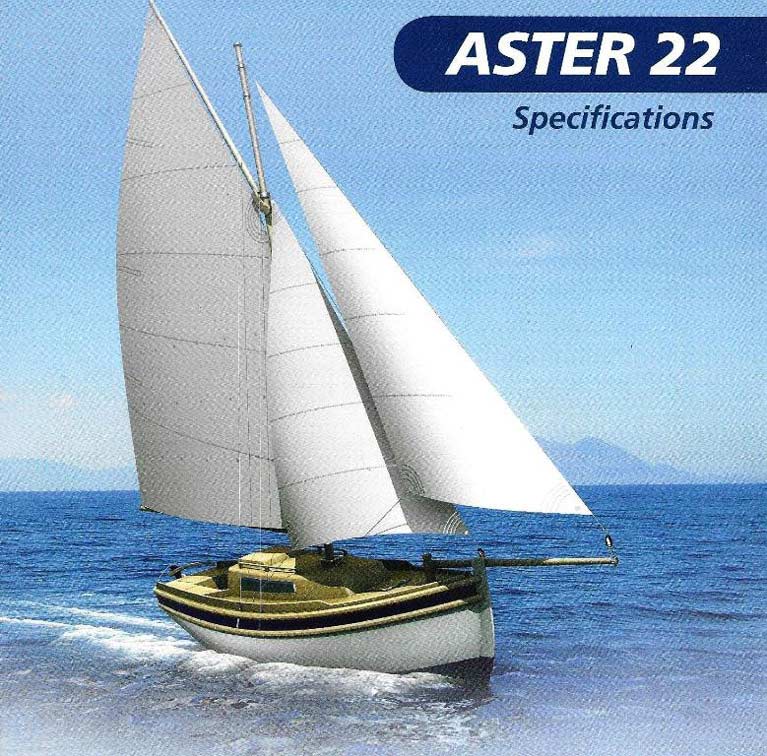 The Aster 22 designed by Adrian O'Connell
The Aster 22 designed by Adrian O'Connell
From a boatyard at Clifden in County Galway where he built fishing boats and the closure of which he blames on the government decision to enter the EU and ”give away the fishing industry,” to Aster Yachts which he now leads as Managing Director is an interesting story, which he told me - after I asked him about that photo of the ‘Leathbád.’
Listen to the Podcast below
Kilrush on the Shannon Estuary Shows the Way for Dun Laoghaire – Again
In 1828, when the recently re-named and still only semi-finished harbour of Kingstown on Dublin Bay staged its first regatta, it certainly gave an indication of the transformed place’s potential for waterborne sport. Yet it was not until 1831 that the first club – the Royal Irish YC in its earliest form – came into being. But on the south coast at Cork, the stately Water Club had been going about its manoeuvres since 1720, and was organising racing by 1765 and probably earlier while going on to become the Royal Cork YC in 1831. And on the west coast in Kerry and along the Shannon Estuary, recreational sailing was relatively well established – not least because it provided a useful cover for some profitable smuggling of low-volume high-value commodities from France, Spain and Portugal.
Be that as it may, by the 1820s regattas were being staged at what was then one of the main ports, the sheltered though tidal Shannonside creek at Kilrush on the south coast of Clare, and in 1828 Maurice “Hunting Cap” O’Connell – the uncle and effectively guardian in his youth of Daniel O’Connell of Derrynane, The Liberator - organised a Kilrush regatta which led to the formation of the Royal Western Yacht Club of Ireland.
The club thrived, and by 1838 it was the named club of at least two dozen yachts, some of them quite substantial, with 18 of them based in Kilrush while others were kept by their owners on moorings in the estuary beside their often quite stately homes, a classic case being the Knight of Glin with his 30-ton cutter Rinevella moored off Glin Castle on the south shore.
 The Shannon Estuary – 55 nautical miles of history-filled waterway
The Shannon Estuary – 55 nautical miles of history-filled waterway
Thus the sailing scene on the Atlantic seaboard was thriving while the Dublin Bay programme was still in its infancy. But the situation was totally and tragically changed with the Great Famine of 1845-47. Apart from the human scale of the disaster - which we still do not fully grasp, and probably never will – while it may be simplistic to say that the economy of Western Ireland was destroyed, basically that’s what happened. Despite this, much of life along the east coast went on as normal, and yachting in Kingstown underwent a phase of rapid development.
Retreating from the wasteland which the West had become, what was left of the Royal Western Yacht Club of Ireland became an itinerant organisation, based for a while in Dublin city and then in Dun Laoghaire and finally in Cork Harbour, where it was supposedly wound up in Cobh in 1870. But it so happened that back in Kilrush the Glynn family had retained some artefacts, documents and records of the old club, other memorabilia was gradually traced and brought home over the years, for there were those who felt that the old Royal Western YC of Ireland had never really died, it was only sleeping, and all it needed was some miraculous revival of the port of Kilrush to waken it up.
Kilrush did slowly revive as a port after the famine, but it was for the utilitarian purposes of handling cargo in the dock, while a pier nearby at Cappagh served the needs of the Shannon ferry steamers which were such a feature of the estuary before rail and then road took over. After that, the port became a ghost of its former self, but there were those who could see its potential.
And the miracle came in 1990, when Brendan Travers of Shannon Development spearheaded the project to provide a barrier with a sea lock to make Kilrush into a proper marina. Today, it has facilities which put the allegedly pace-setting East Coast ports to shame, with the marina run by Simon McGibney while master-shipwright Steve Morris (who’s from New Zealand, but Irish women like his wife Michelle have a way of ensnaring useful talent and keeping it here) has been with the boatyard with its commodious sheds and workshops since 2001, where they seem capable of all forms of boat-work in any material, and to world class standards too.
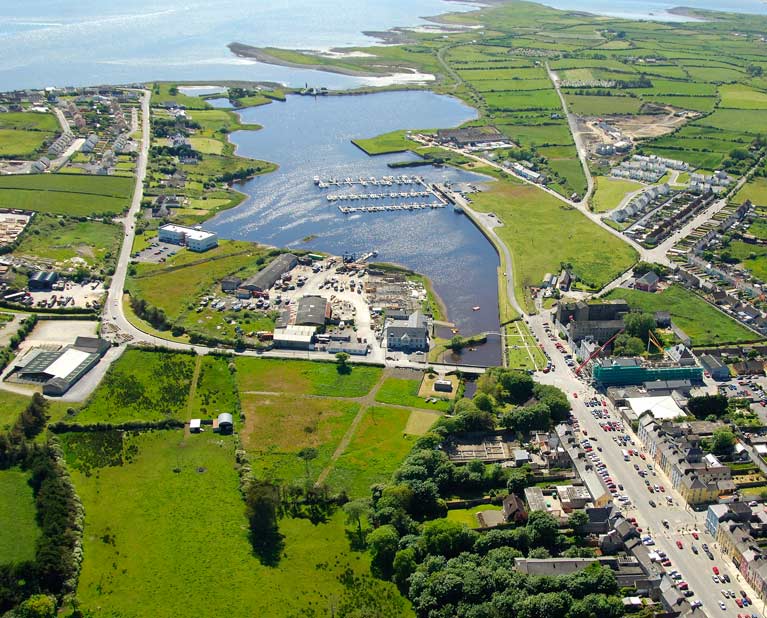 Kilrush today, with the extensive boatyard (centre) providing facilities that most other Irish sailing harbours can only dream of
Kilrush today, with the extensive boatyard (centre) providing facilities that most other Irish sailing harbours can only dream of
With this setup developing, the Royal Western Yacht Club of Ireland re-emerged as the club at Kilrush with a healthy marina-based fleet. In the early summer of 2007, a bundle of energy from Limerick called Ger O’Rourke contacted the Royal Ocean Racing Club to enter his Cookson 50 Chieftain for the up-coming Rolex Fastnet race in August. He was told he’d be 46th on the waiting list, but not to worry - many early entries tended to drop out, and with bad weather forecast, he was in with a good chance of a place.
O’Rourke had just completed a Transatlantic race from Newport to Hamburg to take second place, but he had this weird superstition of never entering his boat for the next big race until the previous one had been completed. Once again it came good - on the Tuesday before the Fastnet was due to start on the Saturday, the RORC told him it was all systems go, the place was there, so he rushed his crew together, they sailed a magnificent heavy weather race, and Chieftain became the overall winner of the 2007 Rolex Fastnet Race, making the Royal Western of Ireland and Kilrush the only Irish club and port which can claim this rare distinction.
 Ger O’Rourke’s Cookson 50 Chieftain from Kilrush shortly after the start of the Rolex Fastnet Race 2007, which she won overall – the first and still the only Irish boat to do so. Photo: Rolex
Ger O’Rourke’s Cookson 50 Chieftain from Kilrush shortly after the start of the Rolex Fastnet Race 2007, which she won overall – the first and still the only Irish boat to do so. Photo: Rolex
All of which is a roundabout way of saying that when the most varied group of people in Irish sailing that you’ve ever seen converged on Kilrush in Tuesday’s incredibly bright and uninterrupted sunshine for the launching of the first of the re-born Dublin Bay 21s which are being brought back to life for Hal Sisk and Fionan de Barra by Steve Morris and the equally talented Dan Mill and their team (which includes Kilrush’s own James Madigan of Ilen fame), we weren’t making a patronizing visit to encourage a new place on its way.
 The Naneen Restoration Team included (left to right) Steve Morris, James Madigan, Hal Sisk, Fionan de Barrra, Fintan Ryan and Dan Mill. Photo: W M Nixon
The Naneen Restoration Team included (left to right) Steve Morris, James Madigan, Hal Sisk, Fionan de Barrra, Fintan Ryan and Dan Mill. Photo: W M Nixon
On the contrary, it was more like a pilgrimage to a special place that was outdone in historic sailing style only by Cork Harbour, for in Dublin Bay organised sailing was just getting going when Kilrush was thriving, and Belfast Lough was likewise barely started. But back in the 1820s when life lacked many of today’s mostly superfluous distractions, sailing was big in the west – think Sligo too - and Kilrush and the Shannon Estuary were in the forefront of its energetic development, typified by the Knight of Glin who took his cutter Rinevella to Galway in 1834 for a big regatta, and won western sailing’s equivalent of the Galway Plate.
However, from 1850 onwards there’s no doubting Dublin Bay was a global pace-setter in sailing development, and the establishment of Dublin Bay Sailing Club in 1884 provided an organisation which very quickly was co-ordinating all the sailing of the three major Kingstown yacht clubs, establishing new classes of increasing boat sizes such that by 1898 it was the DBSC’s imprimatur which brought the famous Fife-designed Dublin Bay 25ft ODs into being.
All these numbers refer to the waterline length, which means the 25s were generously-canvassed 37-footers, the jet-set of Dublin Bay One-Design racing. So much so, in fact, that very soon there was a growing movement for something similar in style but in a smaller and more economically-manageable size. William Fife was busy with America’s Cup yachts for Thomas Lipton and other large projects for super-rich clients, so they turned to Scotland’s new rising star in the yacht design firmament, Alfred Mylne, who had already created a useful 20ft waterline design for Belfast Lough sailors, the Star class, which set a simple gunter sloop rig.
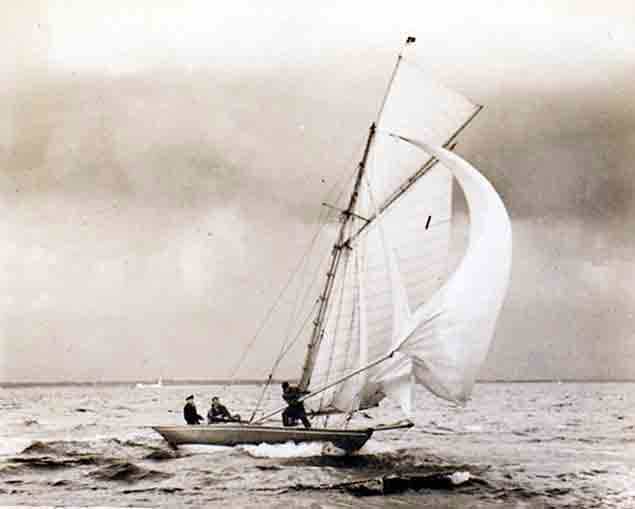 Simplicity was not the keynote in the original rig of the new Dublin Bay 21s in 1903 – in fact, for the first 60 years of their existence, they were defined by this challenging jackyard topsail-setting gaff cutter rig.
Simplicity was not the keynote in the original rig of the new Dublin Bay 21s in 1903 – in fact, for the first 60 years of their existence, they were defined by this challenging jackyard topsail-setting gaff cutter rig.
But simplicity was not the keynote for the new Dublin Bay 21. Slightly larger, she had a longer and more elegant stem than the Star’s rather snubbed bow, and instead of a straightforward hyper-economical gunter mainsail with just one headsail, she set acres of gaff rig with a jackyard topsail and was cutter-rigged with it – four sails by comparison with the Star’s two, and that’s before you add the spinnaker.
The first three boats were building with Hollwey of Ringsend in the winter of 1902-03, as the established Kingstown builders James Clancy and J E Doyle were busy with other works, notably yet more DB 25s. The bigger class had received a shot in the arm with a new boat ordered for the 1903 season for the Viceroy, Lord Dudley, to be built by Doyle. This meant that when the first five DB 21s raced in 1903 (two more having been built by James Kelly of Portrush), their advent was somewhat overshadowed by all the razzmatazz attached to the Viceroy racing in his new DB25 Fodhla.
 Garavogue on her launching day at Portrush in 1903
Garavogue on her launching day at Portrush in 1903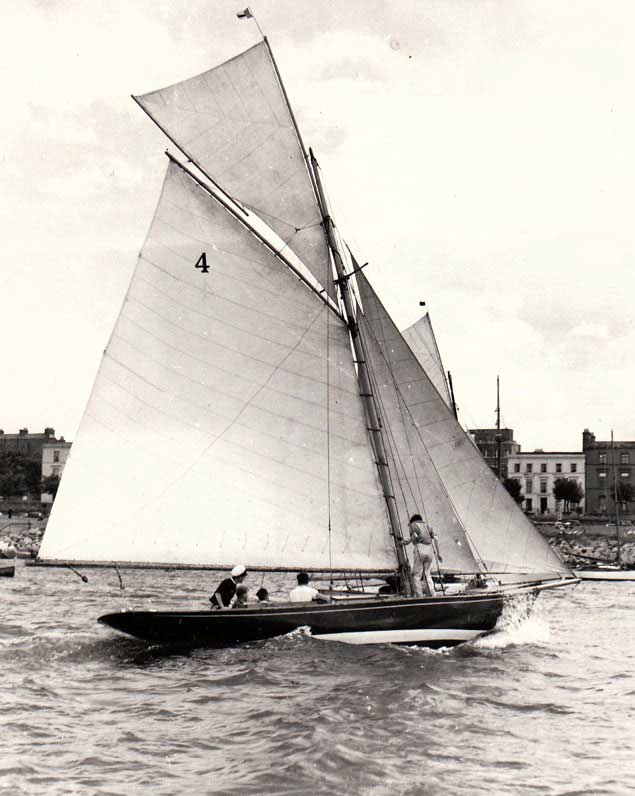 Garavogue in action in Dun Laoghaire Harbour. Her replacement hull has been built by The Elephant Boatyard in England, and is now in Kilrush for completion
Garavogue in action in Dun Laoghaire Harbour. Her replacement hull has been built by The Elephant Boatyard in England, and is now in Kilrush for completion
But the smaller class’s quality was soon recognized, and by 1908 they’d achieved their optimum number of The Sacred Seven with Geraldine being built by Hollwey, while Naneen – no 6 – had emerged as the only Kingstown-built boat. She was the work of James Clancy in 1905, built for a serial racing yacht owner called T Cosby Burrowes from Cavan. He must have owned a substantial part of that most rural of Irish counties, for it was presumably rental income which enabled him to be a member of eleven yacht clubs in Ireland, Scotland and England while buying new boats on a fairly regular basis. But though he raced in many places, Dublin Bay was his spiritual sailing home, and he’d served as DBSC Vice Commodore in 1900-1901.
The Ireland of people like Cosby Burrowes was to change inexorably through the 20th Century, yet the Dublin Bay 21s steadily continued to give great sport with such consistency that, despite being just seven in number, the regularity of their turnouts and the spectacular nature of their appearance became the best-known feature of Dublin Bay sailing.
But by the early 1960s the advent of series-production built fibreglass boats with alloy masts and synthetic sails was making their continued existence problematic, and in 1963 they persuaded veteran designer John Kearney (he was 83 at the time) to provide them with a new masthead Bermudan rig of 400 square feet as opposed to the original gaff’s 600, and they also requested a new coachroof with a doghouse to provide standing headroom.
 The new masthead Bermudan rig as fitted in 1963 enabled exceptional loading to be applied by the standing backstay, while the unsightly new doghouse distracted attention from the elegance of the sheerline.
The new masthead Bermudan rig as fitted in 1963 enabled exceptional loading to be applied by the standing backstay, while the unsightly new doghouse distracted attention from the elegance of the sheerline.
John Kearney was up to his tonsils at the time designing and over-seeing the building of the 54ft yawl Helen of Howth for Perry Greer, but his age of 83 notwithstanding, he took on this extra task and the simple rig he created balanced very well. It gave good performance while needing a smaller crew, but veterans of that Dublin Bay 21 era who were in Kilrush on Tuesday were mixed in their approval.
Paddy Boyd raced on his father’s Oola as a schoolkid, and he could well remember the magic moment when the vital but inadequate bilge pump – his special job - was replaced by a luxurious new Whale Gusher 25. Anyway, he is in no doubt that the new rig gave the class a further 22 years of useful life. But Fionan de Barra, the Keeper of the Flame who has kept The Sacred Seven intact as a group ever since they stopped sailing, and his project partner Hal Sisk, are of the opinion that the new masthead rig with its standing backstay – often tensioned with a wheel - meant that the mast was being pushed down into the hull in a destructive way that hadn’t been possible with the original gaff rig with its running backstays.
 DB21 veteran Paddy Boyd with Naneen in Kilrush. Racing regularly as a schoolboy aboard the family’s Oola, his happiest memory is of the day his father finally acquired a bilge pump which was man enough for the job. Photo: W M Nixon
DB21 veteran Paddy Boyd with Naneen in Kilrush. Racing regularly as a schoolboy aboard the family’s Oola, his happiest memory is of the day his father finally acquired a bilge pump which was man enough for the job. Photo: W M Nixon
Either way, the class was getting very tired by the mid-1980s. But any considered decision as to their future was decided by Hurricane Charlie in August 1986, with northeast gales of unbelievable ferocity sweeping into Dun Laoghaire to leave the Dublin Bay 21s either sunk or seriously damaged.
That was 1986. It is now 2019. But the sheer style of the DB 21s has never been forgotten. And as for what was left of the boats themselves, Fionan de Barra and friends managed to keep them intact as a group in various locations in County Wicklow, while one proposal after another was put forward for their revival.
 Naneen, the only DB21 to have actually been built in Dun Laoghaire, looking very sad in a Wicklow farmyard some years after the class had stopped sailing in 1986. Photo: Afloat.ie/David O’Brien
Naneen, the only DB21 to have actually been built in Dun Laoghaire, looking very sad in a Wicklow farmyard some years after the class had stopped sailing in 1986. Photo: Afloat.ie/David O’Brien
Naturally the yachting historian and classic yacht activist Hal Sisk was interested, but he had other projects in hand such as the restoration of the 1894 G L Watson 37ft cutter Peggy Bawn, a meticulous project finished in 2003 which has seen Peggy Bawn winning regattas and awards on both sides of the Atlantic.
But gradually he and Fionan started putting ideas together, and in a world which changes more rapidly than ever, they reckoned that a way of restoring the DB 21s as a class is to think of new ways of ownership and use. To do this they would have to use a rig simpler than the labour-intensive time-consuming jackyard tops’l setup of the originals, and a straightforward gunter sloop set up such as Alfred Mylne designed for a Scottish-built boat to the hull design – Zanettta in 1918 - seemed to fit the bill.
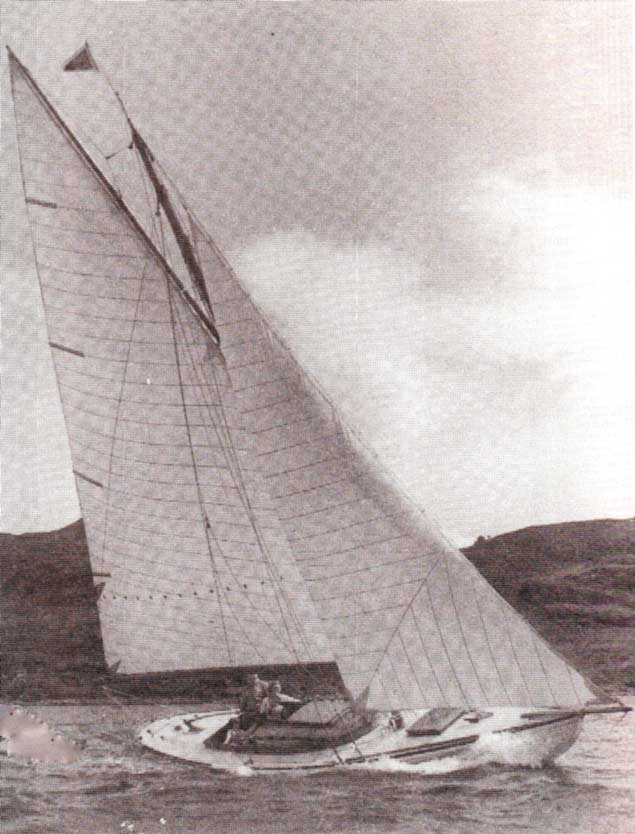 The easily-handled rig designed by Alfred Mylne for the Scottish-owned Zanetta of 1918 is the basic inspiration for the new rig on the class in Dublin Bay
The easily-handled rig designed by Alfred Mylne for the Scottish-owned Zanetta of 1918 is the basic inspiration for the new rig on the class in Dublin Bay
A traditional and historic local class such as the Howth 17s is one in which the people involved and their sense of community through the boat are every bit as important as the new boat itself, and thus the numbers of interested people are maintained over the years. But where a class has been sitting together but derelict and moth-balled for thirty years with the original owners and crews dying off and all ownership rights gradually accruing to one person – in this case Fionan de Barra – much radical thinking is needed.
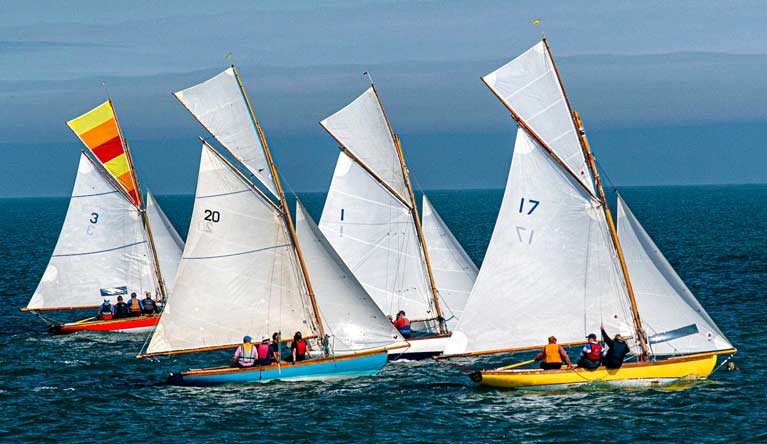 Howth Seventeens in action in their time-honoured style. They have been functioning continuously as a racing class since 1898, and with 19 boats, have an established total crewing panel of around a hundred people for whom a Seventeen is the first choice if they wish to go sailing. But as the new-look Dublin Bay 21s will be starting from scratch with no basic crewing panel, a completely new approach to ownership and the running of the boats is being devised. Photo Stormyphotos/Tom Ryan
Howth Seventeens in action in their time-honoured style. They have been functioning continuously as a racing class since 1898, and with 19 boats, have an established total crewing panel of around a hundred people for whom a Seventeen is the first choice if they wish to go sailing. But as the new-look Dublin Bay 21s will be starting from scratch with no basic crewing panel, a completely new approach to ownership and the running of the boats is being devised. Photo Stormyphotos/Tom Ryan
Thus Hal and Fionan have come up with the idea that the restored Dublin Bay 21 class – with the hulls built-in modern wood-style using the WEST system – would be an association-owned class of boats in a Dun Laoghaire Harbour which is itself being re-imagined for its use as an amenity and recreational area. To this new-use classic harbour they would bring a group of classic boats which are maintained as a unit, and accessible to all for sailing and special racing events based on the harbour of which they were such a natural part for 83 years.
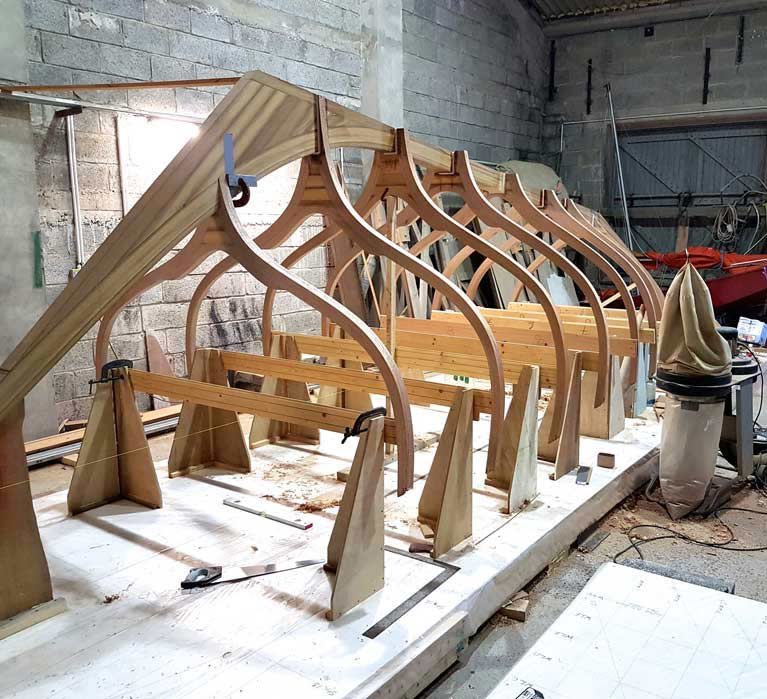 The “new” Naneen at an early stage of her re-build. Photo: Steve Morris
The “new” Naneen at an early stage of her re-build. Photo: Steve Morris
It’s an ambitious idea, but in this age of disappearing private ownership and shared use of vehicles ashore, with new business names like Borrow-a-Boat coming to the fore, it could well be that this re-born 116-year-old class is in the vanguard of how we will sail in the future.
Meanwhile, the boats have had to be re-built, and in Ireland they started with the only Dun Laoghaire-built boat, the Naneen of 1905 built by James Clancy, and took her to Steve Morris in Kilrush, while the Garavogue – built by James Kelly of Portrush in 1903 – went to classic boat specialists The Elephant Boatyard in the south of England.
Even with such skill involved in both England and Ireland, it has been a demanding task, but fortunately beforehand they could draw on the knowledge of design historian and classic specialist Theo Rye, and then after his sad and untimely death in 2016, the many talents of Paul Spooner took on the advisory role, and gradually the developing project began to take shape.
The casually interested might think it is all taking a remarkably long time, but so many novel concepts and new ways of thinking about boat use are evolving as each stage is passed that when the “new” DB21 class is complete, we’ll find that Hal Sisk and Fionan de Barra are true pioneers of sailing.
 A meeting of minds. Ilen skipper Paddy Barry (right) with Frank Larkin (left) and Steve Morris as the about-to-be-launched Naneen flies the DBSC burgee. Photo: W M Nixon
A meeting of minds. Ilen skipper Paddy Barry (right) with Frank Larkin (left) and Steve Morris as the about-to-be-launched Naneen flies the DBSC burgee. Photo: W M Nixon
Certainly the very supportive crowd which turned up in the Kilrush sunshine on Tuesday to wish them and the build team of Steve Morris and Dan Mill was representative of a very wide swathe of people seriously interested in classic boats and what you can do with them, such as Paddy Barry and Jarlath Cunnane fresh back from the restored Ilen’s voyage to Greenland, and James Madigan who was not only closely involved in re-building the Ilen in Limerick and Oldcourt and sailing to Greenland, but is from Kilrush and is now back home working with Steve and Dan on completing the Garavogue, whose hull has arrived in Kilrush from England.
There were several there who had sailed on the DB21s in the old days, in fact your columnist sailed in the Geraldine when she was still gaff-rigged in the ownership of Paul Johnson. But much more interesting were the views of Paddy Boyd, who has distant childhood memories of the old rig, and happy recollections of youthful exuberance under the new one.
In gazing at Naneen as she glowed in the sunshine with a sense of weightlessness in the boat hoist, he was moved to comment on how elegant the sheerline now looked under the original coachroof. John Kearney himself preferred neat low coachroofs - he thought doghouses were the invention of the devil - but the DB 21 owners of 1963 demanded it, and the result was a boxy shape which somehow disguised the fact that the original sheerline was well nigh perfect.
Certainly it was well-appreciated by Ian Malcolm of Howth, who was there on behalf of the Howth 17s but with a special interest, for after Storm Emma wreaked havoc on the Howth Seventeen fleet in their pier-end storage shed in March 2018, it was boat no 6, Anita built by James Clancy in 1900, which was the only total loss. Thus it fell to Ian, with his French connections, to arrange her re-build by Paul Roberts’ Les Atelier d’Enfer organisation in Douarnenez under the French government’s subsidized boat-building schools programme.
 People who re-build James Clancy boats with James Clancy people are left to right) Ian Malcolm who arranged the French re-build of Howth 17 No 6 Anita, built by James Clancy in 1900, with Ann Clancy Griffin, James Clancy’s grand-daughter who lives in Kilrush, James Clancy’s great-grand-daughter Sinead Griffin (also of Kilrush), and Hal Sisk, who has been central to the re-build of Naneen, DB 21 No 6, built by James Clancy in 1905. Photo: W M Nixon
People who re-build James Clancy boats with James Clancy people are left to right) Ian Malcolm who arranged the French re-build of Howth 17 No 6 Anita, built by James Clancy in 1900, with Ann Clancy Griffin, James Clancy’s grand-daughter who lives in Kilrush, James Clancy’s great-grand-daughter Sinead Griffin (also of Kilrush), and Hal Sisk, who has been central to the re-build of Naneen, DB 21 No 6, built by James Clancy in 1905. Photo: W M Nixon
This meant that in Kilrush on Tuesday we’d two sets of people who have been closely involved in the re-building of a Clancy of Dun Laoghaire boat during the past two years, but the coincidences didn’t stop there, as James Clancy married a Kilrush woman, and the family now has many connection in the town, with his grand-daughter Ann Clancy Griffin with her daughter Sinead Griffin doing the launching honours after Father Anthony Keane – who was Brother Anthony Keane of Glenstal Abbey before he went up to Greenland on Ilen – had made a quietly elegant ceremony out of blessing the boat.
 When he sailed to Greenland in the Ilen in July, he was Brother Anthony of Glenstal Abbey, but now he is Father Anthony Keane, and in his new capacity, he blessed Naneen before her launching on Tuesday. Photo: W M Nixon
When he sailed to Greenland in the Ilen in July, he was Brother Anthony of Glenstal Abbey, but now he is Father Anthony Keane, and in his new capacity, he blessed Naneen before her launching on Tuesday. Photo: W M Nixon
And then Naneen was launched. Simply by watching her being lowered gently we were given ample opportunity to admire the way in which Alfred Myne has harmonised the lines, such that every sweet curve complements all the other, with the little cabin, in particular, being a masterpiece. On the original drawings Mylne light-heartedly named its interior as “The Den”, but the 21s proved such good seaboats that one of the original owners, Herbert Wright who later went on to be founding Commodore of the Irish Cruising Club in 1929, took his new DB21 Estelle to Scotland on a cruise which worked out so well he wrote it up for Yachting Monthly magazine, which prompted Hal Sisk to claim that the Dublin Bay 21s were thus the world’s first genuine cruiser-racer class.
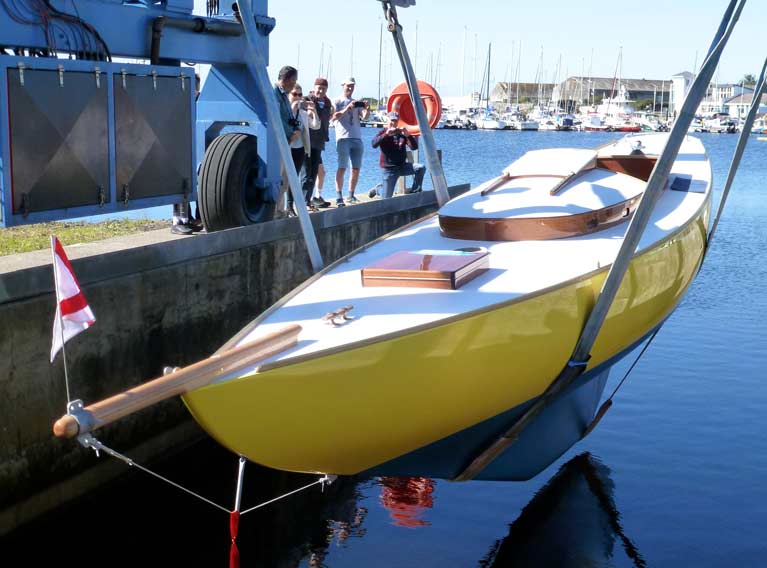 The harmony of Naneen’s pure lines as drawn by Alfred Mylne became even more evident as she was lowered gently into Kilrush Creek. Photo: W M Nixon
The harmony of Naneen’s pure lines as drawn by Alfred Mylne became even more evident as she was lowered gently into Kilrush Creek. Photo: W M Nixon
 Is she not very lovely? That Alfred Mylne, he certainly had an eye for a boat….. Photo: W M Nixon
Is she not very lovely? That Alfred Mylne, he certainly had an eye for a boat….. Photo: W M Nixon
Clearly there’s a quality to their size and the way they feel when you step aboard which seems just right, and suggests uses more ambitious than simply racing in Dublin Bay, though heaven knows the pace of their racing was scarcely simple, for it was hectic and furiously – sometimes genuinely furiously – competitive.
But all would be well at the end of the day, and with the new creation afloat, Fionan ushered us back to the boat-building shed for the perfect boat-launching lunch, a simple yet effective and nourishing boat-oriented meal provided by Noel Ryan of Ryan’s Butchers & Deli in the town. It was an extension of the opportunity to meet the huge diversity of people who had come to wish this extraordinary project well, a glimpse of the area’s diversity for there was time to talk with Frank Larkin of Limerick, whom I first met through sailing. Then when he became Corporate Communications Manager for Shannon Development, he used to recruit me to give slide shows to Limerick’s sailing fraternity, and the next day we’d go to Foynes or Kilrush to see the developing local setup, all extremely educational for this was in the days before Kilrush had its barrier and Foynes had yet to have its largely voluntarily-installed marina.
 The perfect post-launch boatyard lunch gets underway beside a new traditional gleoiteog which is another high-standard project the yard has underway at the moment. Photo: W M Nixon
The perfect post-launch boatyard lunch gets underway beside a new traditional gleoiteog which is another high-standard project the yard has underway at the moment. Photo: W M Nixon
There too was Kim Roberts who has run a boatyard in her time, and then driven an enormous crane for big contracts on the south shore, and has since been manager of Kilrush marina but is now running Vandeleur antiques from The Old Forge in Killimer and sailing a restored classic timber Drascombe which, as we saw last week, she has taken about as far up the Shannon as it is possible to get from Kilrush.
From up the Shannon was David Beattie of Lough Ree, whose steel version of Slocum’s Spray may have originated in the Lough Ree area, but now under David’s command she has cruised extensively in the Med before returning recently to Ireland for work to be done at the Ryan & Roberts boatyard at Askeaton on the Shannon Estuary’s south shore. And equally appreciative of the Naneen restoration was that legendary shipwright sailor Albert Foley, who’s on the mend after a recent illness, and plans to get his Swan 36 – which he re-built after everyone else considered her a write-off after she’d been run down by a survey vessel – back sailing again.
Then came the moment of truth - the post-lunch revisit to the floating Naneen to see how things were. The sheer pleasure of being aboard a pristine wooden boat in the sunshine with new varnishwork and a slight hint of linseed oil and all the aromas of a healthy environment in The Den were followed by that important ceremony: The First Lifting of the Floorboards.
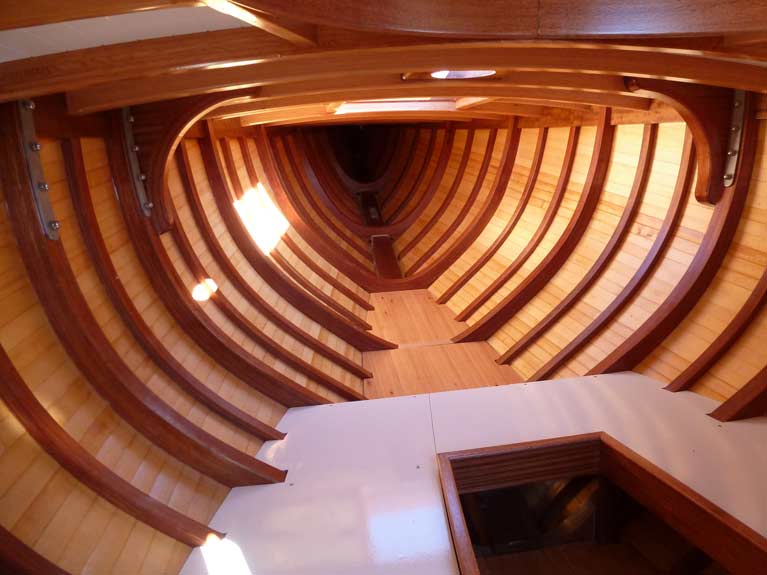 Super workmanship in evidence below on Naneen, looking forward from “The Den”. Photo: W M Nixon
Super workmanship in evidence below on Naneen, looking forward from “The Den”. Photo: W M Nixon
They’ll have a problem with Naneen. No arachnophobes will be able to sail aboard. The bilges fore and aft were bone dry. Inevitably some dust and other peculiar forms of nutrition and the occasional tiny insect will find their way in, and in time there will be a spider’s web or two. Definitely not a boat for arachnophobes……
 Exquisite workmanship hiding structural strength – the hanging knee fitted in Naneen to distribute the load from the internally-installed main shroud chainplate. Photo: W M Nixon
Exquisite workmanship hiding structural strength – the hanging knee fitted in Naneen to distribute the load from the internally-installed main shroud chainplate. Photo: W M Nixon
Before leaving Kilrush for the long haul home courtesy of Ian Malcolm with his high-and-very-mighty boat-towing vehicle, we had one further pleasant task – to pay our respects to Sally O’Keeffe in the marina. She is the handsome workmanlike 25ft cutter designed by the talented Myles Stapleton to a concept based on the Shannon Estuary hookers of all sizes which used to carry cargoes the length and breadth of the mighty waterway, and there was one in particular called Sally O’Keeffe which was based in Querrin to the west of Kilrush, where she’s part of folk memory.
A sort of Men’s Shed group in Querrin got together to build an interpretation of the Sally in the big barn at a local farm, Steve Morris came along and kept the work on track, and the result is one of the most attractive boats in all Ireland, a no-nonsense multi-purpose craft which has turned heads and won competitions at places as far apart as Glandore, the Baltimore Woodenboat Festival in West Cork, and Cruinniu na mBad in Kinvara on Galway Bay, making a point of sailing to these places along the Atlantic seaboard from Kilrush.
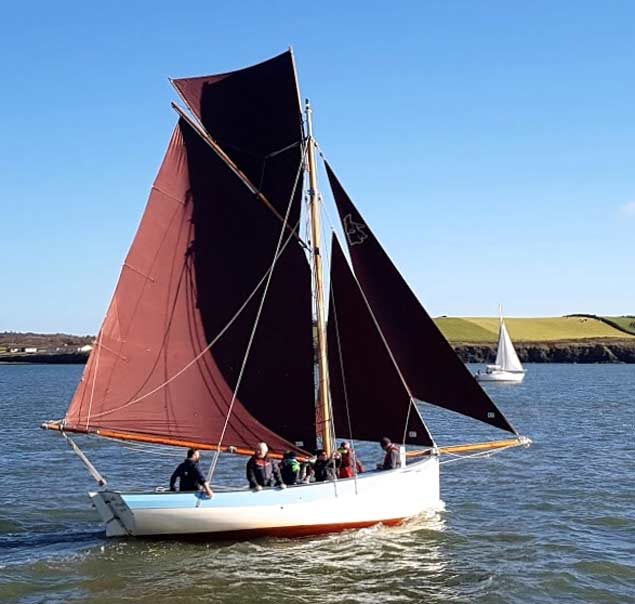 Sally O’Keeffe is the outcome of a very successful community venture in neighbourhood boat-building guided by Steve Morris.
Sally O’Keeffe is the outcome of a very successful community venture in neighbourhood boat-building guided by Steve Morris. Steve Morris – he seems to be able to turn his hand to any boat-building project with complete success. Photo: W M Nixon
Steve Morris – he seems to be able to turn his hand to any boat-building project with complete success. Photo: W M Nixon
She’s about as perfect as you can get in her way, yet she’s as different as possible from the equally perfect Naneen, and we’d the chance to compare them directly, for even as we were admiring Sally, the Naneen came into the berth just across the walkway.
All I can say is that when some project gets the Steve Morris touch, it becomes something very special indeed. We departed on a high, determined to make the best of that extraordinary day by enveloping the entire Shannon Estuary experience through heading homewards by way of the Killimer-Tarbert Ferry, and along the south shore we were able to look across to the islands at the mouth of the estuary of the Fergus River where the 1886 America’s Cup Challenger Galatea came to visit Paradise House (that’s really what it was called), the Shannonside ancestral home of owner William Henn.
Then we swept into Foynes to admire the crisp style of the thriving yacht club while gazing thoughtfully across to the cottage on Foynes Island where global circumnavigation pioneer Conor O’Brien of Saoirse fame spent his last years, and where the restored Ilen had come in the Autumn of last year to pay her respects, and then we went to see Cyril Ryan and the wide range of work he does at Ryan & Roberts at Askeaton, where he has a boatyard in classic style where we marvelled at the huge road crane Kim Roberts used to drive, and marvelled equally at the enormous tidal range in the River Deel, for David Beattie’s Ree Spray was a very long way down indeed in a muddy pool at the pontoon.
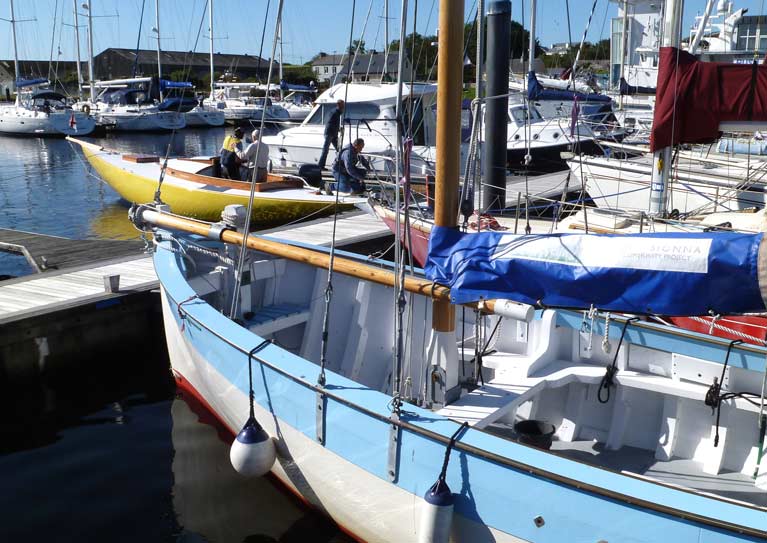 Product line…..the “new” Naneen (beyond) and Sally O’Keeffe (foreground) get together in Kilrush Marina at the end of an extraordinary day. Photo: W M Nixon
Product line…..the “new” Naneen (beyond) and Sally O’Keeffe (foreground) get together in Kilrush Marina at the end of an extraordinary day. Photo: W M Nixon
And finally, we went for a pit stop in the Dunraven Arms in Adare and wondered again at the sometimes misunderstood genius of the neighbourhood’s Lord Dunraven, with his two America’s Cup Challenges in 1893 and 1895. Then with a seemingly eternal sunset at our backs, we left Ireland and went back across the isthmus to Howth, simply stunned by the memory of the incredible range of the Shannon Estuary’s sailing history and its many links, a memory which had somehow given us a much clearer understanding of what it is that Hal Sisk and Fionan de Barra are trying to achieve with their pioneering vision for the future of the DB21 class.
 Naneen is coming home….Naneen, the only Dublin Bay 21 to be actually built in Dun Laoghaire, is the first one to be restored. She is seen here in the successful ownership of Terry Roche during the 1950s. Photo courtesy Olga Scully
Naneen is coming home….Naneen, the only Dublin Bay 21 to be actually built in Dun Laoghaire, is the first one to be restored. She is seen here in the successful ownership of Terry Roche during the 1950s. Photo courtesy Olga Scully



























